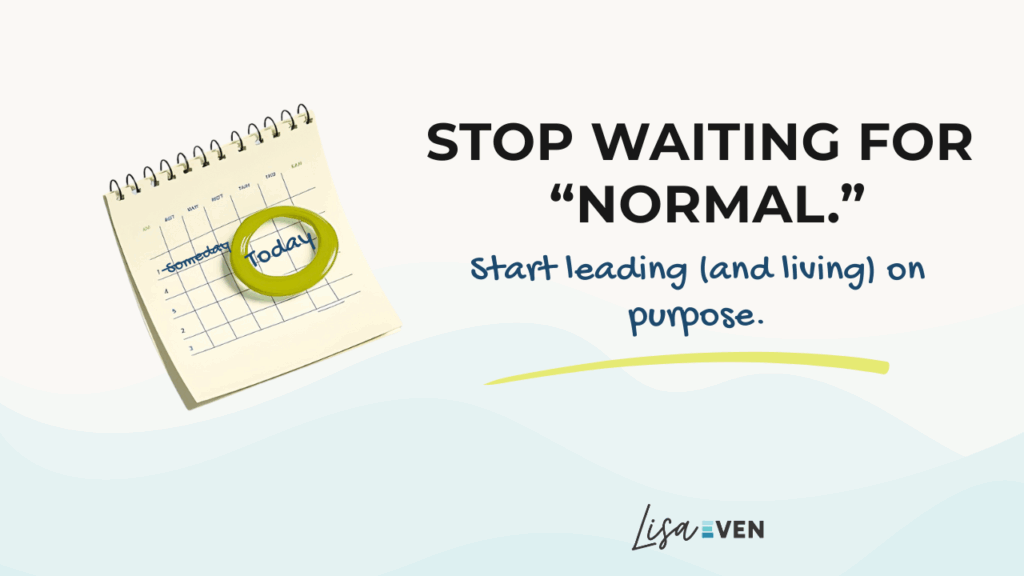
Ever find yourself waiting for the “right time” to start something?
Same.
We tell ourselves that after the next deadline or once the schedule calms down, we’ll get to the things that matter — sanity, rest, connection, or even just a walk around the block. But both in leadership and in life, there’s a mindset shift that changes everything:
Stop waiting for normal. Start leading (and living) on purpose.
Here’s what that’s looked like for me lately:
LEADERSHIP: Stop Waiting for Normal…
When I was a new leader, I fell into a pattern — one I now see a lot of leaders repeat.
I’d say things like:
“After this quarter, things will get back to normal.”
“Once this staffing shortage is over, we’ll be in a better spot.”
“After the holidays, things will finally settle down.”
Each morning, I’d start with a to-do list. I’d time block, attend back-to-back meetings, and inevitably get pulled into firefighting. I knew the SOPs needed updating, the cross-training had to happen, the outdated processes needed fixing, and the employee development plans deserved attention — but all of that lived in “someday.”
I wasn’t being naive. I was coping — trying to make sense of the chaos.
But there was always something.
By my fourth or fifth year in leadership, I realized: it wasn’t going to change… unless I did.
That was the turning point. I put my figurative foot down and reframed my thinking:
It’s always going to be busy.
There will always be fires, deadlines, and curveballs.
So the question isn’t “when will things calm down?”
It’s “how do I lead anyway?”
That mindset shift changed everything.
When a fire popped up, I’d pause and ask:
Is the house going to burn down if I wait two hours?
Or does this just feel urgent because adrenaline makes me feel productive?
I built a better internal decision tree. If I had protected time for a proactive, strategic task, I honored it. Unless the issue was truly five-alarm, it could wait.
And here’s what I didn’t expect:
My team followed suit.
When they brought me a problem, I’d say:
“Thanks for flagging this — does it need to be solved in the next two hours, or can I finish something and then come find you?”
We were prioritizing — together.
It worked.
I stopped living in the weeds and started carving out time to work on the team, not just in it — focusing on strategy, development, and the habits that actually move the needle.
And here’s what I’ve come to believe:
The highest-performing teams aren’t just busy — they’re intentional.
They know the pace of business won’t slow down, but they don’t let it sweep them away.
They don’t cross their fingers and hope for a strong culture.
They build it.
Culture isn’t a set of words on a poster.
It’s how your team functions — the habits, traditions, decision-making rhythms, and day-to-day behaviors that shape your results.
It shows up in how you organize time, escalate issues, solve problems, and lead under pressure.
And the truth is: whether you realize it or not, you’re always building culture. The question is whether you’re doing it on purpose.
Great teams are intentional — because culture isn’t a “nice-to-have” once things calm down.
It’s a now strategy. One that directly fuels performance, retention, and results.
If your team is moving fast but you’re ready to move smarter — make culture your competitive edge.
LIFE: Intentionality Isn’t Just for Work
In leadership, we talk a lot about being intentional instead of reactive. But that mindset matters at home, too.
Most of us move through the week on autopilot (or on the edge of our sanity) — chasing the next duty (cleaning, cooking, laundry), solving the next problem (dishwasher not working, broken lamp, air conditioner making weird noises), and telling ourselves we’ll get to the good stuff later.
Exercise. Home-cooked meals. More time for joy.
Someday, right?
But what if you could hold both? The urgent and the important.
What if you could be the firefighter and the architect?
About a year ago, I started working out again. And for months, every time I showed up to class, my brain told me I had better things to do. I’d spend half the class thinking about my to-do list and feeling equal parts guilt and relief when it ended — like, “Now I can finally get back to what really matters.”
But now? It’s a habit. I don’t just make time for it — I protect time for it.
And what’s wild? The rest of life still gets done.
I’m actually better at the chaos because I’ve carved out something for myself in the middle of it.
So here’s your challenge:
What’s one thing you’ve been wanting to fit into your life — exercise, cooking, journaling, or just 15 minutes of nothing — that keeps getting shoved to “someday”?
And is there something you’re firefighting that could actually wait 30 minutes?
The house probably won’t burn down. Yes, you might feel slightly guilty or awkward at first.
And you might just find you’re better for the rest of it if you go.
